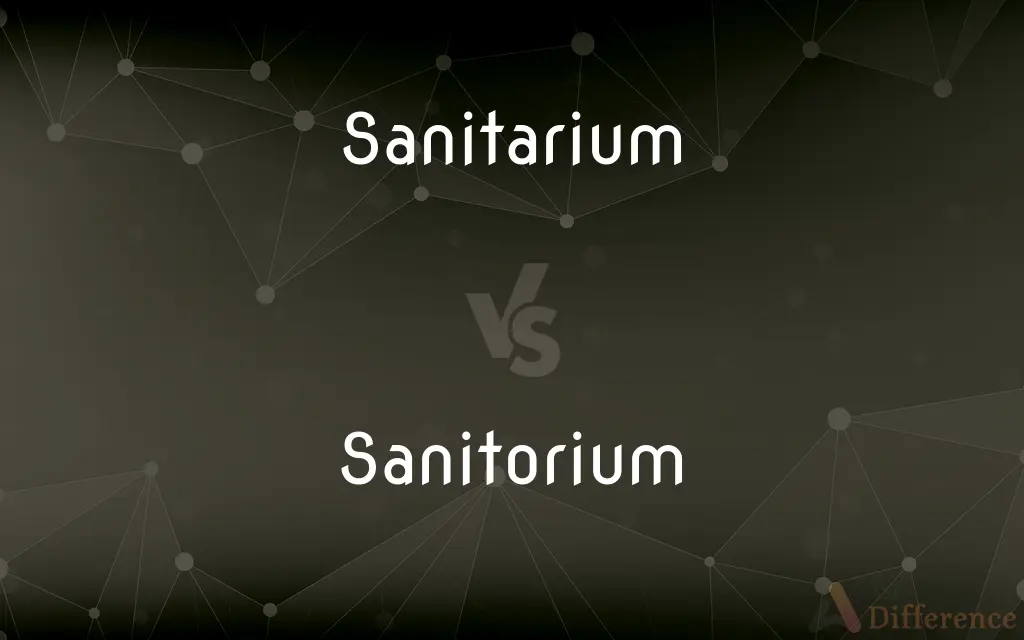Sanitarium vs. Sanitorium — What's the Difference?
Edited by Tayyaba Rehman — By Fiza Rafique — Published on March 4, 2024
A sanitarium focuses on long-term illness treatment, often for tuberculosis, while a sanitorium offers a place for health recovery, typically through rest and specific climates.

Difference Between Sanitarium and Sanitorium
Table of Contents
ADVERTISEMENT
Key Differences
Sanitariums were originally established as medical facilities for the treatment of chronic illnesses, especially tuberculosis, before antibiotics were available. They provided both medical care and a supportive environment for patients over long periods. Sanitoriums, on the other hand, were more broadly focused on offering patients a place to recuperate and recover their health, often leveraging beneficial climates and peaceful settings without the strict medical focus of sanitariums.
The terms are sometimes used interchangeably, while their origins reflect distinct purposes. Sanitariums have a more direct association with medical treatment and care, specifically targeting diseases that require ongoing attention. Sanitoriums emphasize rest and recovery, often in scenic or health-promoting environments, suggesting a broader approach to wellness that includes physical and mental rest.
In modern usage, the distinction between sanitariums and sanitoriums has blurred, with both terms often referring to facilities that provide healthcare or rehabilitation services. However, the historical distinction highlights the former's focus on medical treatment and the latter's on convalescence and wellness.
The evolution of medical science and public health measures has decreased the prevalence of traditional sanitariums and sanitoriums, as diseases like tuberculosis became treatable with antibiotics and other modern therapies. Today, facilities that inherit these names may offer a range of health and wellness services, from medical care to spa-like rejuvenation, reflecting a blend of their historical purposes.
Comparison Chart
Primary Focus
Medical treatment of chronic illnesses, especially tuberculosis.
Health recovery and convalescence, often leveraging beneficial climates.
ADVERTISEMENT
Origin
Late 19th to early 20th century, for tuberculosis care.
Developed for general health improvement and rest, not limited to specific diseases.
Treatment Approach
Emphasizes medical care and long-term treatment.
Focuses on rest, relaxation, and recovery in a health-promoting environment.
Setting
Often located in rural or secluded areas to prevent disease spread and provide a healing environment.
Typically situated in scenic or climatically favorable locations to promote wellness.
Modern Usage
Less common due to advances in medical treatments; some have evolved into modern healthcare facilities.
While traditional sanitoriums are rare, the concept persists in wellness and spa retreats focusing on recovery and relaxation.
Compare with Definitions
Sanitarium
A medical facility for long-term illness treatment, particularly tuberculosis.
My great-grandfather was treated in a sanitarium for his tuberculosis in the 1920s.
Sanitorium
Emphasizes rest and relaxation in a beneficial climate.
The sanitorium by the sea offered therapeutic walks on the beach.
Sanitarium
Historically significant in the fight against tuberculosis.
Sanitariums played a crucial role before the era of antibiotics.
Sanitorium
A facility offering a place for health recovery, not limited to one illness.
After his surgery, he spent a month in a sanitorium to recuperate.
Sanitarium
Can be a term for modern healthcare facilities with historical roots.
The facility, once a tuberculosis sanitarium, is now a modern hospital.
Sanitorium
Can offer treatments like hydrotherapy or physiotherapy.
The sanitorium specialized in hydrotherapy for its recuperating patients.
Sanitarium
Focuses on both medical care and a supportive environment for recovery.
The sanitarium provided patients with nutritional meals designed to boost their health.
Sanitorium
Often located in scenic or climatically favorable locations.
Nestled in the hills, the sanitorium was a perfect retreat for those needing rest.
Sanitarium
Often located in rural areas for health benefits.
The sanitarium was situated in the mountains, believing the fresh air would aid in recovery.
Sanitorium
The term can apply to modern wellness and spa retreats.
The luxury sanitorium offered yoga and meditation alongside traditional spa treatments.
Sanitarium
See sanatorium.
Sanitorium
Alternative spelling of sanatorium
Sanitarium
(US) sanatorium
Sanitarium
A health station or retreat; a sanatorium.
Sanitarium
A hospital for recuperation or for the treatment of chronic diseases
Common Curiosities
What is a sanitarium?
A facility for the medical treatment of long-term illnesses, historically significant for tuberculosis care.
How did sanitariums and sanitoriums differ in their approach to tuberculosis?
Sanitariums offered medical care for tuberculosis, while sanitoriums focused on general health recovery, which could include tuberculosis patients seeking restorative benefits.
Are sanitariums still common today?
Traditional sanitariums are less common due to medical advancements, but some facilities have evolved into modern healthcare centers.
Can a sanitorium offer medical treatments?
Yes, some sanitoriums offer treatments like hydrotherapy and physiotherapy, though their primary focus is on rest and relaxation.
Can someone go to a sanitorium for mental health recovery?
Historically, sanitoriums were more focused on physical health, but modern equivalents may offer programs for mental wellness and stress recovery.
How does the concept of a sanitorium differ from a modern spa?
While both emphasize relaxation and health, sanitoriums historically offered a more medical or therapeutic approach to recovery.
Have modern healthcare facilities replaced sanitariums?
Yes, advancements in medical treatment and public health have largely made traditional sanitariums obsolete, with many transforming into general healthcare facilities.
How do the settings of sanitariums and sanitoriums compare?
Both were often located in areas considered beneficial for health, though sanitariums focused more on seclusion and sanitoriums on scenic or climatically favorable locations.
What made sanitariums effective before antibiotics?
They provided a combination of medical care, a supportive environment, and believed health benefits of clean air and nutrition.
Why were sanitariums often located in rural or secluded areas?
To prevent disease spread and to provide patients with a clean, healing environment, often believed to be beneficial for conditions like tuberculosis.
Do sanitoriums still exist?
While traditional sanitoriums are rare, the concept lives on in wellness and spa retreats focused on recovery and relaxation.
What is a sanitorium?
A place for health recovery and convalescence, often emphasizing rest and a beneficial climate.
What was the main goal of a sanitorium?
To provide a restful and health-promoting environment for individuals recovering from illness or seeking to improve their general health.
Did sanitariums only treat tuberculosis?
While tuberculosis was a primary focus, sanitariums also treated other chronic illnesses requiring long-term care.
Why might someone choose a sanitorium over a hospital for recovery?
For the benefits of a restful environment, therapeutic climate, and specific recovery programs not typically offered in hospital settings.
Share Your Discovery

Previous Comparison
Stainless Steel vs. Galvanized SteelNext Comparison
Intrinsic Semiconductor vs. Extrinsic SemiconductorAuthor Spotlight
Written by
Fiza RafiqueFiza Rafique is a skilled content writer at AskDifference.com, where she meticulously refines and enhances written pieces. Drawing from her vast editorial expertise, Fiza ensures clarity, accuracy, and precision in every article. Passionate about language, she continually seeks to elevate the quality of content for readers worldwide.
Edited by
Tayyaba RehmanTayyaba Rehman is a distinguished writer, currently serving as a primary contributor to askdifference.com. As a researcher in semantics and etymology, Tayyaba's passion for the complexity of languages and their distinctions has found a perfect home on the platform. Tayyaba delves into the intricacies of language, distinguishing between commonly confused words and phrases, thereby providing clarity for readers worldwide.
















































